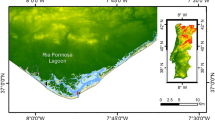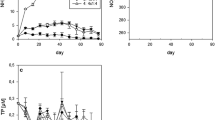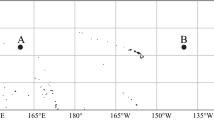Abstract
Nitrate and ammonium are the most important nitrogen sources for phytoplankton growth. Differential utilization of inorganic nitrogenous compounds by phytoplankton has been observed and may have significant impacts on primary productivity at local scales. We used enrichment experiments with natural phytoplankton populations from the freshwater tidal zone of the Guadiana estuary, a coastal ecosystem increasingly subjected to anthropogenic influences, to study the effects of nitrate and ammonium on N-consumption and phytoplankton growth. In addition, we used combined additions of nitrate and ammonium to understand the inhibitory effect of ammonium over nitrate uptake. Ammonium concentrations in the freshwater tidal reaches of the Guadiana estuary throughout the sampling period were too low to exert an inhibitory effect on nitrate uptake or a toxic effect on phytoplankton growth. Nitrate was clearly the main nitrogen source for phytoplankton at the study site. Overall, nitrate seemed to become limiting at concentrations lower than 20 μM and N-limitation was particularly significant during summer. A trend of decreasing nitrate uptake with increasing ammonium concentrations and uptake suggested an overall preference for ammonium. However, preference for ammonium was group-specific, and it was observed mainly in green algae and cyanobacteria. In fact, cyanobacteria relied only on ammonium as their N-source. On the contrary, diatoms preferred nitrate, and did not respond to ammonium additions. The increasing eutrophication in the Guadiana estuary and particularly increased inputs of nitrogen as ammonium due to urban waste effluents may result in a shift in phytoplankton community composition, towards a dominance of cyanobacteria and green algae.








Similar content being viewed by others
References
Admiraal W (1977) Tolerance of estuarine benthic diatoms to high concentrations of ammonia, nitrite ion, nitrate ion and orthophosphate. Mar Biol 43:307–315
Baek SH, Shimode S, Han M-S, Kikuchi T (2008) Growth of dinoflagellates, Ceratium furca and Ceratium fusus in Sagami Bay, Japan: the role of nutrients. Harmful Algae 7:729–739
Balode M, Purina I, Béchemin C, Maestrini SY (1998) Effects of nutrient enrichment on the growth rates and community structure of summer phytoplankton from the Gulf of Riga, Baltic Sea. J Plankton Res 20:2251–2272
Barbosa AB, Domingues RB, Galvão HM (2010) Environmental forcing of phytoplankton in a Mediterranean estuary (Guadiana estuary, south-western Iberia): a decadal study of climatic and anthropogenic influences. Est Coasts 33:324–341
Blasco D, Conway HL (1982) Effect of ammonium on the regulation of nitrate assimilation in natural phytoplankton populations. J Exp Mar Biol Ecol 61:157–168
Borsuk ME, Stow CA, Reckhow KH (2004) Confounding effect of flow on estuarine response to nitrogen loading. J Environ Eng 130:605–614
Carpenter EJ, Dunham S (1985) Nitrogenous nutrient uptake, primary production, and species composition of phytoplankton in the Carmans River estuary, Long Island, New York. Limnol Oceanogr 30:513–526
Chang FH, McLean M (1997) Growth responses of Alexandrium minutum (Dinophyceae) as a function of three different nitrogen sources and irradiance. N Z J Mar Freshw Res 31:1–7
Cloern JE (2001) Our evolving conceptual model of the coastal eutrophication problem. Mar Ecol Prog Ser 210:223–253
Dokulil MT, Teubner K (2000) Cyanobacterial dominance in lakes. Hydrobiologia 438:1–12
Domingues RB, Galvão H (2007) Phytoplankton and environmental variability in a dam regulated temperate estuary. Hydrobiologia 586:117–134
Domingues RB, Barbosa A, Galvão H (2005) Nutrients, light and phytoplankton succession in a temperate estuary (the Guadiana, south-western Iberia). Est Coast Shelf Sci 64:249–260
Domingues RB, Anselmo TA, Barbosa AB, Sommer U, Galvão HM (2010) Nutrient limitation of phytoplankton growth in the freshwater tidal zone of a turbid, Mediterranean estuary. Est Coast Shelf Sci. doi:10.1016/j.ecss.2010.10.033
Dortch Q (1982) Response of marine phytoplankton to nitrogen deficiency: decreased nitrate uptake vs. enhanced ammonium uptake. Mar Biol 70:13–19
Dortch Q (1990) The interaction between ammonium and nitrate uptake in phytoplankton. Mar Ecol Prog Ser 61:183–201
Dortch Q, Clayton JR Jr, Thoresen SS, Ahmed SI (1984) Species differences in accumulation of nitrogen pools in phytoplankton. Mar Biol 81:237–250
Dugdale RC, Goering JJ (1967) Uptake of new and regenerated forms of nitrogen in primary production. Limnol Oceanogr 12:196–206
Dugdale RC, Wilkerson FP, Hogue VE, Marchi A (2007) The role of ammonium and nitrate in spring bloom development in San Francisco Bay. Est Coast Shelf Sci 73:17–29
Flores E, Herrero A (2005) Nitrogen assimilation and nitrogen control in cyanobacteria. Biochem Soc Trans 33:164–167
Flynn KJ, Fasham MJR, Hipkin CR (1997) Modelling the interactions between ammonium and nitrate uptake in marine phytoplankton. Philos Trans R Soc Lond B 352:1625–1645
Fowler J, Cohen L (1990) Practical statistics for field biology. Wiley, London
Grasshoff K, Ehrhardt M, Kremling K (1983) Methods of seawater analysis. Verlag Chemie, Weinheim
Haas LW (1982) Improved epifluorescence microscopy for observing planktonic micro-organisms. Ann Inst Oceanogr 58:261–266
Hillebrand H, Sommer U (1996) Nitrogenous nutrition of the potentially toxic diatom Pseudonitzschia pungens f. multiseries Hasle. J Plankton Res 18:295–391
Hyenstrand P, Burkert U, Pettersson A, Blomqvist P (2000) Competition between the green alga Scenedesmus and the cyanobacterium Synechococcus under different modes of inorganic nitrogen supply. Hydrobiologia 435:91–98
Incharoensakdi A, Wangsupa J (2003) Nitrate uptake by the halotolerant cyanobacterium Aphanothece halophytica grown under non-stress and salt-stress conditions. Curr Microbiol 47:255–259
Intergovernmental Panel on Climate Change (IPCC) (2001) Climate change 2001: the scientific basis. Cambridge University Press, Cambridge
Leong SCY, Taguchi S (2004) Response of the dinoflagellate Alexandrium tamarense to a range of nitrogen sources and concentrations: growth rate, chemical carbon and nitrogen, and pigments. Hydrobiologia 515:215–224
Maguer J-F, L’Helguen S, Waeles M, Morin P, Riso R, Caradec J (2009) Size-fractionated phytoplankton biomass and nitrogen uptake in response to high nutrient load in the North Biscay Bay in spring. Cont Shelf Res 29:1103–1110
McCarthy J, Taylor W, Taft J (1977) Nitrogenous nutrition of the plankton in the Chesapeake Bay. I. Nutrient availability and phytoplankton preferences. Limnol Oceanogr 22:996–1011
Morales JA (1995) Sedimentología del estuario del río Guadiana. Ph.D. thesis, University of Huelva, 322 p. (in Spanish)
Nixon SW (1995) Coastal marine eutrophication: a definition, social causes, and future concerns. Ophelia 41:199–219
Parsons TR, Maita Y, Lalli CM (1984) A manual of chemical and biological methods for seawater analysis. Pergamon Press, Oxford
Pennock JR (1987) Temporal and spatial variability in phytoplankton ammonium and nitrate uptake in the Delaware Estuary. Est Coast Shelf Sci 24:841–857
Probyn TA (1985) Nitrogen uptake by size-fractionated phytoplankton populations in the southern Benguela upwelling system. Mar Ecol Prog Ser 22:249–258
Tada K, Suksomjit M, Ichimi K, Funaki Y, Montani S, Yamada M, Harrison PJ (2009) Diatoms grow faster using ammonium in rapidly flushed eutrophic Dokai Bay, Japan. J Oceanogr 65:885–891
Takeda S, Kamatani A, Kawanobe K (1995) Effects of nitrogen and iron enrichments on phytoplankton communities in the northwestern Indian Ocean. Mar Chem 50:229–241
Taub FB (2009) Community metabolism of aquatic closed ecological systems: effects of nitrogen sources. Adv Space Res 44:949–957
Torres-Valdés S, Purdie DA (2006) Nitrogen removal by phytoplankton uptake through a temperate non-turbid estuary. Est Coast Shelf Sci 70:473–486
Toscas PJ (2008) Spatial modelling of the probability of obtaining a detectable concentration of ammonia in Moreton Bay, Australia. Environ Monit Assess 137:379–385
Twomey LJ, Piehler MF, Paerl HW (2005) Phytoplankton uptake of ammonium, nitrate and urea in the Neuse River Estuary, NC, USA. Hydrobiologia 533:123–134
Utermöhl H (1958) Zur Vervollkommung der quantitativen Phytoplankton-Methodik. Verh Internat Verein Limnol 9:1–38
Venrick EL (1978) How many cells to count? In: Sournia A (ed) Phytoplankton manual. UNESCO, Paris, pp 167–180
Wafar M, L’Helguen S, Raikar V, Maguer J-F, Le Corre P (2004) Nitrogen uptake by size-fractionated plankton in permanently well-mixed temperate coastal waters. J Plankton Res 26:1207–1218
Wilkerson FP, Dugdale RC, Hogue VE, Marchi A (2006) Phytoplankton blooms and nitrogen productivity in San Francisco Bay. Est Coasts 29:401–406
Yoshiyama K, Sharp JH (2006) Phytoplankton response to nutrient enrichment in an urbanized estuary: apparent inhibition of primary production by overeutrophication. Limnol Oceanogr 51:424–434
Acknowledgments
The authors would like to thank C. Luís and T.P. Anselmo for technical assistance. This work was financially supported by the Portuguese Foundation for Science and Technology (FCT) through project DYNCYANO (PTDC/AMB/64747/2006). FCT provided funding for R.B.D. through a Ph.D. Grant (SFRH/BD/27536/2006).
Author information
Authors and Affiliations
Corresponding author
Rights and permissions
About this article
Cite this article
Domingues, R.B., Barbosa, A.B., Sommer, U. et al. Ammonium, nitrate and phytoplankton interactions in a freshwater tidal estuarine zone: potential effects of cultural eutrophication. Aquat Sci 73, 331–343 (2011). https://doi.org/10.1007/s00027-011-0180-0
Received:
Accepted:
Published:
Issue Date:
DOI: https://doi.org/10.1007/s00027-011-0180-0




